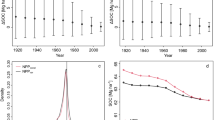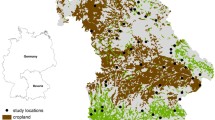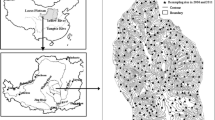Abstract
This study provides an estimate of soil organic carbon (SOC) stock, projects future SOC stocks under different climate change scenarios, and considers impacts on topsoil SOC in Mount Everest region using the Rothamsted carbon (RothC) model. According to our estimates, the average SOC stock in the region is 85.34 t C/ha. The SOC stock for different land use types ranges from 29.67 to 156.87 t C/ha following the order: agricultural land > forest > pasture. A significant decreasing trend has been found between the SOC content and altitude. Climate change scenario derived from HADGEM2-CC global climate model at 30 second resolution driven by Representative Concentration Pathway (RCP) 4.5 and RCP8.5 indicates that the temperature in the region will increase by 2.87 and 3.51°C by 2050, respectively. Precipitation is projected to increase by 4.46 and 2.70% for RCP 4.5 and RCP 8.5, respectively. With this change in climatic condition, the average SOC stock in the region is projected to decrease significantly (by 8.56% for RCP 4.5 and 5.13% for RCP 8.5) by 2050 thereby increasing the amount of CO2 entering into the atmosphere by 50% on the average. Release of CO2 from soil carbon pool into the atmosphere is likely to enhance the warming trend through the SOC-climate positive feedback, exacerbating effects of climate change.





Similar content being viewed by others
REFERENCES
K. Abdalla, M. Mutema, and T. Hill, “Soil and organic carbon losses from varying land uses: a global meta-analysis,” Geogr. Res. 58 (2), 167–185 (2020). https://doi.org/10.1111/1745-5871.12389
J. Álvaro-Fuentes, M. Easter, and K. Paustian, “Climate change effects on organic carbon storage in agricultural soils of northeastern Spain,” Agric. Ecosyst. Environ. 155, 87–94 (2012).
H. H. Ayeni, “Combined effect of cattle dung and urea fertilizer on organic carbon forms of nitrogen and available phosphorus in selected Nigerian soils,” J. Cent. Eur. Agric. 13, 610–616 (2012). https://doi.org/10.5513/JCEA01/13.3.1098
G. Barancikova, M. Guttekova, J. Makovnikova, M. Novakova, R. Skalsky, and Z. Tarasovicova, “Application of RothC Model to predict soil organic carbon stock on agricultural soils of Slovakia,” Soil Water Res. 5, 1–9 (2010).
S. Bhandari and S. Bam, “Comparatives study of soil organic carbon (SOC) under forest, cultivated and barren land: a case of Chovar Village, Kathmandu,” Nepal J. Sci. Technol. 14, 103–108 (2013).
T. Bhattacharyya, D. K. Pal, P. Chandran, S. K. Ray, C. Mandal, and B. Telpande, “Soil carbon storage capacity as a tool to prioritize areas for carbon sequestration,” Curr. Sci. 95 (4), 482-494 (2008).
G.R. Blake, “Bulk density in methods of soil analysis,” Agronomy 9, 374–390 (1965).
A. Byers, “Contemporary human impacts on alpine ecosystems in the Sagarmatha (Mt. Everest) National Park, Khumbu, Nepal,” Ann. Assoc. Am. Geogr. 95, 1467–8306 (2005). https://doi.org/10.1111/j.1467-8306.2005.00452.x
A. Byers, “Landscape change and man-accelerated soil loss: the case of the Sagarmatha (Mt. Everest) National Park, Khumbu, Nepal,” Mt. Res. Dev. 7, 209–216 (1987).
K. Coleman and D. S. Jenkinson, “RothC-26.3—a model for the turnover of carbon in soil,” in Evaluation of Soil Organic Matter Models Using Existing Long-Term Datasets, Ed. by D. S. Powlson, P. Smith, and J. U. Smith, J.U. (Springer-Verlag, Heidelberg, 1996), pp. 237–246.
K. Coleman and D. S. Jenkinson, “RothC—A model for the turnover of carbon in soil,” in Evaluation of Soil Organic Matter Models: Using Existing Long-Term Datasets (Springer-Verlag, Berlin, 1996), pp. 237–246.
E. A. Davidson and I. A. Janssens, “Temperature sensitivity of soil carbon decomposition and feedbacks to climate change,” Nature 440 (7081), 165–173 (2006). https://doi.org/10.1038/nature04514
P. Falloon, P. Smith, K. Coleman, and S. Marshall, “Estimating the size of the inert organic matter pool from total soil organic carbon content for use in the Rothamsted carbon model,” Soil Biol. Biochem. 30, 1207–1211 (1998).
S. K. Gami, J. Duxbury, and J. Lauren, “Modeling of carbon dynamics under rice-wheat systems using Rothc-26.3,” in Proceedings of the 2007 International Annual Meetings “A Century of Integrating Crops, Soils and Environment” (American Society of Agronomy, Madison, WI, 2007).
P. Gottschalk, J. U. Smith, M. Wattenbach, J. Bellarby, E. Stehfest, N. Arnell, T. J. Osborn, C. Jones, and P. Smith, “How will organic carbon stocks in mineral soils evolve under future climate? Global projections using RothC for a range of climate change scenarios,” Biogeosciences 9, 3151–3171 (2012). https://doi.org/10.5194/bg-9-3151-2012
L. B. Guo and R. M. Gifford, “Soil carbon stocks and land use change: a meta-analysis,” Global Change Biol. 8, 345–360 (2002).
M. Heimann and M. Reichstein, “Terrestrial ecosystem carbon dynamics and climate feedbacks,” Nature 451, 289–292 (2008). https://doi.org/10.1038/nature06591
R. Hiederer and M. Köchy, Global Soil Organic Carbon Estimates and the Harmonized World Soil Database (European Commission, Joint Research Centre, Institute for Environment and Sustainability, Ispra, 2011). https://doi.org/10.2788/13267
R. J. Hijmans, S. E. Cameron, J. L. Parra, G. Jones, and A. Jarvis, “Very high resolution interpolated climate surfaces for the global land areas,” Int. Jouranl Climatol. 25, 1965–1978 (2005). https://doi.org/10.1002/joc.1276
J. T. Houghton, G. J. Jenkins, and J. J. Ephraums, Climate Change: The IPCC Scientific Assessment-Report prepared for Intergovernmental Panel on Climate Change by Working Group I (Cambridge University Press, Cambridge, 1990).
H. H. Janzen, “Beyond carbon sequestration: soil as conduit of solar energy,” Eur. J. Soil Sci. 66, 19–32 (2015). https://doi.org/10.1111/ejss.12194
D. Jenkinson, D. E. Adams, and A. Wild, “Model estimates of CO2 emissions from soil in response to global warming,” Nature 351, 304–306 (1991).
C. Jones, C. Mcconnell, K. Coleman, P. Cox, P. Falloon, D. Jenkinson, and D. Powlson, “Global climate change and soil carbon stocks; predictions from two contrasting models for the turnover of organic carbon in soil,” Global Change Biol. 11, 154–166 (2005). https://doi.org/10.1111/j.1365-2486.2004.00885.x
M. U. F. Kirschbaum, “Will changes in soil organic carbon act as a positive or negative feedback on global warming?” Biogeochemistry 48, 21–51 (2000).
M. U. F. Kirschbaum, “The temperature dependence of soil organic matter decomposition, and the effect of global warming on soil organic carbon storage,” Soil Biol. Biochem. 27, 753–760 (1995).
V. N. Kudeyarov, V. A. Demkin, D. A. Gilichinskii, S. V. Goryachkin, and V. A. Rozhkov, “Global climate changes and the soil cover,” Eurasian Soil Sci. 42, 953–966 (2009). https://doi.org/10.1134/S1064229309090014
R. Lal, “Soil carbon sequestration to mitigate climate change,” Geoderma 123, 1–22 (2004). https://doi.org/10.1016/j.geoderma.2004.01.032
J. Leifeld, S. Bassin, and J. Fuhrer, “Carbon stocks in Swiss agricultural soils predicted by land-use, soil characteristics, and altitude,” Agric., Ecosyst. Environ. 105, 255–266 (2005). https://doi.org/10.1016/j.agee.2004.03.006
D. K. Limbu, M. Koirala, and Z. Shang, “Total carbon storage in Himalayan Rangeland of Milke-Jaljale area, Eastern Nepal,” J. Agric. Sci. Technol. A 3, 775–781 (2013).
J. Liski, D. Perruchoud, and T. Karjalainen, “Increasing carbon stocks in the forest soils of western Europe,” For. Ecol. Manage. 169, 159–175 (2002).
D. L. Liu, K. Y. Chan, M. K. Conyers, G. Li, and G. J. Poile, “Simulation of soil organic carbon dynamics under different pasture managements using the RothC carbon model,” Geoderma 165, 69–77 (2011). https://doi.org/10.1016/j.geoderma.2011.07.005
X. Lu, S. Zhang, and J. Xu, “Climate change and sediment flux from the roof of the World,” Earth Surf. Landforms 35, 732–735 (2010). https://doi.org/10.1002/esp.1924
National Adaptation Program of Action (NAPA) to Climate Change (Ministry of Environment, Katmandu, 2010)
Climate Change Scenarios of Nepal (Ministry of Forest and Environment, Katmandu, 2019).
Initial National Communication to the Conference of the Parties of the United Nations Framework Convention on Climate Change (Ministry of Population and Environment, Katmandu, 2004).
D. W. Nelson and L. E. Sommers, “Total carbon, organic carbon, and organic matter,” in Methods of Soil Analysis, Part 3: Chemical Methods, (Soil Science Society of America, American Society of Agronomy, Madison, WI, 1996), pp. 961–1010.
M. V. Noordwijk, C. Cerri, P. L. Woomer, K. Nugroho, and M. Bernoux, “Soil carbon dynamics in the humid tropical forest zone,” Geoderma 79, 187–225 (1997). https://doi.org/10.1016/S0016-7061(97)00042-6
T. R. Pearson, S. L. Brown and R. A. Birdsey, Measurement Guidelines for the Sequestration of Forest Carbon: General Technical Report (US Department of Agriculture Forest Service, Boise, ID, 2007).
J. Peck, Growing Food at the Top of the World: A Case Study of Greenhouses in Khumbu, Nepal (S.I.T. Nepal, Katmandu, 2009).
J. Post, T. Conradt, F. Suckow, V. Krysanova, F. Wechsung, and F. F. Hattermann, “Integrated assessment of cropland soil carbon sensitivity to recent and future climate in the Elbe River basin,” Hydrol. Sci. J. 53, 1043–1058 (2008). https://doi.org/10.1623/hysj.53.5.1043
D. S. Powlson, P. Smith, and J. U. Smith, Evaluation of Soil Organic Matter Models: Using Existing Long-Term Datasets, NATO ASI Series vol. 38 (Springer-Verlag, Berlin, 1996).
D. Rhode, D. B. Madsen, P. J. Brantingham, and T. Dargye, “Yaks, yak dung, and prehistoric human habitation of the Tibetan Plateau,” Dev. Quat. Sci. 9, 205–224 (2007). https://doi.org/10.1016/S1571-0866(07)09013-6
F. Salerno, N. Guyennon, S. Thakuri, G. Viviano, E. Romano, E. Vuillermoz, P. Cristofanelli, P. Stocchi, G. Agrillo, Y. Ma, and G. Tartari, “Weak precipitation, warm winters and springs impact glaciers of south slopes of Mt. Everest (central Himalaya) in the last 2 decades (1994–2013),” Cryosphere 9, 1229–1247 (2015). https://doi.org/10.5194/tc-9-1229-2015
D. S. Schimel, B. H. Braswell, E. A. Holland, R. McKeown, D. S. Ojima, T. H. Painter, W. J. Parton, and A. R. Townsend, “Climatic, edaphic, and biotic controls over storage and turnover of carbon in soils,” Global Biogeochem. Cycles 8, 279–293 (1994).
H. Shaheen, Y. Saeed, M. K. Abbasi, and A. Khaliq, “Soil carbon stocks along an altitudinal gradient in different land-use categories in Lesser Himalayan foothills of Kashmir,” Eurasian Soil Sci. 50, 432–437 (2017). https://doi.org/10.1134/S106422931704010X
Y. D. Sherpa and R. B. Kayastha, “A study of livestock management patterns in Sagarmatha National Park, Khumbu Region: trends as affected by socio- economic factors and climate change,” Kathmandu Univ. J. Sci. Eng. Technol. 5, 110–120 (2009).
B. Shrestha, C. P. Wake, P. A. Mayewski and J. E. Dibb, “Maximum temperature trends in the Himalaya and its vicinity: an analysis based on temperature records from Nepal for the period 1971–1994,” J. Clim. 12, 2775–2786 (1999).
B. M. Shrestha and B. R. Singh, “Soil and vegetation carbon pools in a mountainous watershed of Nepal,” Nutr. Cycl. Agroecosyst. 81, 179–191 (2008). https://doi.org/10.1007/s10705-007-9148-9
B. M. Shrestha, O. B. Dick, and B. Singh, “Effects of land-use change on carbon dynamics assessed by multi-temporal satellite imagery in a mountain watershed of Nepal,” Acta Agric. Scand. Sect. B 60, 10–23 (2010). https://doi.org/10.1080/09064710802537678
B. M. Shrestha, B. K. Sitaula, B. R. Singh, and R. M. Bajracharya, “Fluxes of CO2 and CH4 in soil profiles of a mountainous watershed of Nepal as influenced by land use, temperature, moisture and substrate addition,” Nutr. Cycl. Agroecosyst. 68, 155–164 (2004). https://doi.org/10.1023/B
B. M. Shrestha, B. K. Sitaula, B. R. Singh, and R. M. Bajracharya, “Soil organic carbon stocks in soil aggregates under different land use systems in Nepal,” Nutr. Cycl. Agroecosyst. 70, 201–213 (2004).
B. K. Sitaula, R. M. Bajracharya, B. R. Singh and B. Solberg, “Factors affecting organic carbon dynamics in soils of Nepal/Himalayan region—a review and analysis,” Nutr. Cycl. Agroecosyst. 70, 215–229 (2004).
J. O. Smith, P. Smith, M. Wattenbach, S. Zaehle, R. Hiederer, R. J. Jones, L. Montanarella, M. D. Rounsevell, I. Reginster, and F. Ewert, “Projected changes in mineral soil carbon of European croplands and grasslands, 1990–2080,” Global Change Biol. 11, 2141–2152 (2005). https://doi.org/10.1111/j.1365-2486.2005.01075.x
P. Smith, “Land use change and soil organic carbon dynamics,” Nutr. Cycl. Agroecosyst. 81, 169–178 (1999).
P. Smith, J. Smith, M. Wattenbach, J. Meyer, M. Lindner, S. Zaehle, R. Hiederer, R. J. A. Jones, L. Montanarella, M. Rounsevell, I. Reginster, and S. Kankaanpää, “Projected changes in mineral soil carbon of European forests, 1990–2100,” Can. J. Soil Sci. 86, 159–169 (2006). https://doi.org/10.4141/S05-078
E. Somanathan and R. Bluffstone, “Biogas: clean energy access with low-cost mitigation of climate change,” Environ. Resour. Econ. 62, 265–277 (2015). https://doi.org/10.1007/s10640-015-9961-6
M. Stergiadi, M. van der Perk, A. C. M. de Nijs and M. F. P. Bierkens, “Effects of climate change and land management on soil organic carbon dynamics and carbon leaching in Northwestern Europe,” Biogeosci. Discuss. 13, 1519–1536 (2016). https://doi.org/10.5194/bgd-12-19627-2015
K. H. Tan, Soil Sampling, Preparation, and Analysis (CRC Press, Boca Raton, FL, 2005).
S. Tang, J. Guo, S. Li, J. Li, S. Xie, X. Zhai, C. Wang, Y. Zhang, and K. Wang, “Synthesis of soil carbon losses in response to conversion of grassland to agriculture land,” Soil Tillage Res. 185, 29–35 (2019). https://doi.org/10.1016/j.still.2018.08.011
C. W. Thronthwaite, “An approach toward a rational classification of climate,” Geogr. Rev. 38, 55–94 (1948).
S. Trumbore, O. Chadwick, and R. Amundson, “Rapid exchange between soil carbon and atmospheric carbon dioxide driven by temperature change,” Science 272 (5260), 393–396 (1996).
Case Study on Climate Change and World Heritage, Sagarmatha National Park (UNESCO/World Heritage Centre, United Nations Foundation, Paris, 2007)
T. P. Upadhyay, P. L. Sankhayan, and B. Solberg, “A review of carbon sequestration dynamics in the Himalayan region as a function of land-use change and forest/soil degradation with special reference to Nepal change,” Agric. Ecosyst. Environ. 105, 449–465 (2005). https://doi.org/10.1016/j.agee.2004.09.007
A. Walkley and I. A. Black, “An examination of the Degtjareff method for determining soil organic matter, and a proposed modification of the chromic soil titration method,” Soil Sci. 37, 29–38 (1934).
Y. Wan, E. Lin, W. Xiong, and L. Guo, “Modeling the impact of climate change on soil organic carbon stock in upland soils in the 21st century in China,” Agric. Ecosyst. Environ. 141, 23–31 (2011). https://doi.org/10.1016/j.agee.2011.02.004
F. P. Wang, X. C. Wang, B. Q. Yao, Z. H. Zhang, G. X. Shi, Z. Ma, Z. Chen, and H. K. Zhou, “Effects of land-use types on soil organic carbon stocks: a case study across an altitudinal gradient within a farm-pastoral area on the eastern Qinghai-Tibetan Plateau, China,” J. Mt. Sci. 15 (12), 2693–2702 (2018). https://doi.org/10.1007s11629-018-4980-8.
R. Wieder, G. B. Bonan, and S. D. Allison, “Global soil carbon projections are improved by modeling microbial processes,” Nat. Clim. Change 3, 909–912 (2013). https://doi.org/10.1038/nclimate1951
X. Xu, W. Liu, and G. Kiely, “Modeling the change in soil organic carbon of grassland in response to climate change: effects of measured versus modeled carbon pools for initializing the Rothamsted Carbon model,” Agric. Ecosyst. Environ. 140, 372–381 (2011). https://doi.org/10.1016/j.agee.2010.12
ACKNOWLEDGMENTS
The first author is the recipient of Chandra Gurung Memorial Fellowship from WWF Nepal. This work is a part of the fellowship. The authors would like to thank WWF Nepal, The Glacier Trust, UK and Department of National Park and Wildlife Conservation, Nepal for their support to conduct this research.
Author information
Authors and Affiliations
Corresponding author
Ethics declarations
The authors declare no conflict of interest.
Supplementary Information
Rights and permissions
About this article
Cite this article
Chauhan, R., Thakuri, S. & Koirala, M. Modeling Soil Organic Carbon Dynamics in Response to Climate Change in Mount Everest Region of Nepal. Eurasian Soil Sc. 54, 1141–1151 (2021). https://doi.org/10.1134/S1064229321080056
Received:
Revised:
Accepted:
Published:
Issue Date:
DOI: https://doi.org/10.1134/S1064229321080056




